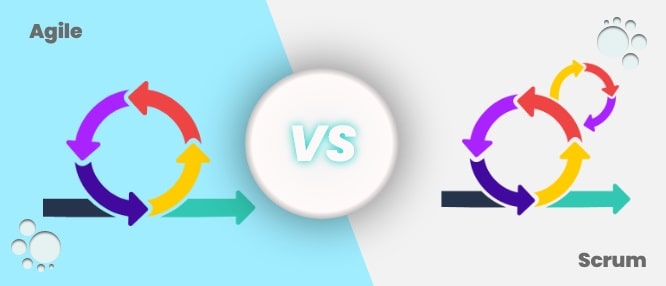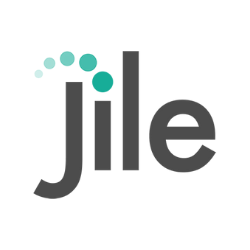Agile vs. Scrum: Importance in Your Agile Project Management Journey

If you are in the Agile or Scrum space, chances are that one of these terms is an integral part of your vocabulary and you want to know the exact difference between Agile & Scrum. Agile has been around for over two decades and it continues to be a popular methodology for developing software products. Meanwhile, Scrum has emerged as another option for product development because it offers some advantages over Agile. This blog post will explain Scrum vs Agile: how they work differently, Agile project management with Scrum, and which one might be the right fit for your business.
What is Agile?
Agile is an umbrella term that refers to a variety of software development methodologies. The most popular Agile methodology today is Scrum. Agile was created in the early 2000s as an alternative to traditional waterfall software development methods. Agile emphasizes collaboration, feedback, and iteration over rigid planning and documentation.
The goal of Agile is to produce high-quality software products that meet the needs of the customer. To do this, Agile teams utilize short cycles called sprints. At the end of each sprint, the team evaluates what was accomplished and determines what needs to be done next. This allows for constant adjustments and helps ensure that the project aspects remain relevant to the customer's needs. Agile teams remain flexible throughout the development process, allowing them to quickly adapt and pivot if necessary.
Another key aspect of Agile is its emphasis on self-organization and cross-functional collaboration: all members of the team work together to accomplish their shared goal.
In Short, Agile vs Scrum is nothing but one is an orientation or philosophy, and the other is a specific methodology respectively.
Agile - How it Benefits the Customers?
The Agile methodology is extremely beneficial for customers because it allows them to have a voice in the development process. In traditional waterfall software development, customers are typically given a requirements document at the beginning of the project and then they are not involved until the end when they are asked to sign off on the product. Agile, on the other hand, involves customers throughout the entire process. This gives customers an opportunity to provide feedback and make changes early on, before any significant investments have been made.
This also helps ensure that the final product meets customer needs and is something that they will actually want to use. Agile teams work closely with their clients to get constant feedback and make sure that all stakeholders are happy with the direction of the project.
Agile - How it Benefits the Vendors?
From the vendor's perspective, Agile offers several benefits:
-
a. Quality:
Agile emphasizes the importance of delivering high-quality software products. This means that vendors have to put in extra effort upfront to ensure that the product is well-designed and meets customer needs.
-
b. Visibility:
Agile provides transparency into the development process, which allows vendors to track their progress and identify potential roadblocks early.
-
c. Cost Control:
Agile helps keep costs under control by using short cycles and sprints that allow for constant adjustments.
-
d. Risk Management:
Agile helps mitigate risks by identifying potential problems and addressing them early.
Get in touch for Agile Portfolio Management!
What is Scrum?
Scrum is an Agile methodology that emphasizes project management. It was developed in the early 1990s by Jeff Sutherland and Ken Schwaber, who were both experienced developers with backgrounds in Agile methodologies.
At its core, Scrum is a framework for making sure that teams remain focused on their goals throughout the development process while also allowing them to respond quickly when necessary. In Agile, teams are self-organizing and work together to accomplish their shared project goals. Scrum takes this a step further by using roles within the team hierarchy:
- 1. Scrum Master – basically serves as a coach or facilitator for the team; coordinates activities between development team members and ensures that everyone is on track with their assigned tasks.
- 2. Product Owner – represents the customers/stakeholders in terms of deciding which features will be developed next (note: it's important for Product Owners not only to understand what they want but also leave room for flexibility).
- 3. Development Team – works on implementing various user stories into working software components; often includes up to nine people who handle all aspects of product development from design to testing.
The goal of Scrum is to ensure that the Development Team can work as efficiently as possible in order to deliver a high-quality product that meets customer needs.
Scrum Simplicity
One of the biggest benefits of Scrum is that it focuses on simplicity. Scrum takes this even further by requiring Agile developers to work together across all roles (i.e., not siloing each team member into their specific role). Having development teams take an active part in product design also helps ensure that only necessary features are included rather than including unnecessary ones because “someone else wants them”.
This approach ensures that the product meets customer needs while still being built efficiently without overcomplicating things or investing unnecessarily large amounts of time and resources.
Scrum also emphasizes quality by focusing on building the right product instead of just trying to build it as quickly as possible (which is one of Agile's main goals). Scrum ensures that each component works well with other components, which helps prevent bugs from slipping through the cracks.
Also, maintaining a working backlog allows teams to work efficiently without wasting time or making any unnecessary changes because they can see at once everything that needs to be done.
Flexibility
Scrum allows teams to be more autonomous and self-organizing. This helps ensure that teams are able to work together in the most effective way possible while still remaining responsive to sudden changes or unexpected problems.
In addition, using short cycles (known as sprints) allows for constant adjustments and prevents teams from becoming bogged down in unnecessary details.
Overall, Scrum offers many benefits that can help organizations deliver high-quality products on time and within budget.
Communication and Collaboration
Scrum teams are self-organized and work collaboratively to accomplish goals. Scrum takes Agile a step further by incorporating roles:
- The scrum master focuses on removing impediments and making sure the team stays on track
- A product owner represents stakeholders, makes decisions about what gets included in each sprint, and prioritizes tasks for the development team.
- The development team works together across all phases of product design to deliver working components at the end of each sprint (typically lasting one week).
The goal is to release features frequently while maintaining quality assurance. At any given time, there should be only three things that can disrupt a sprint: external dependencies, pre-planned events such as holidays or vacation days from individual workers, and unknown tasks that arise.
Difference Between Agile and Scrum
The Agile Scrum framework has a few differences. For starters, Agile methodology focuses on delivering working software quickly while Scrum takes this a step further by incorporating roles and emphasizing quality assurance. Agile also allows teams to be more autonomous and self-organizing, whereas Scrum master works to remove impediments and make sure that the team stays on track. In addition, using short cycles (known as sprints) allows for constant adjustments and prevents teams from becoming bogged down in unnecessary details. Overall, Agile project management with Scrum offers many benefits that can help organizations deliver high-quality products on time and within budget.
Conclusion
Agile vs Scrum are two of the most popular project management frameworks today. Scrum and Agile methodology, both offer a variety of benefits, but there are a few key differences between them. It is important to understand your organizational needs before implementing any of these methodologies. With Jile, you can ensure the maximum benefits from Agile and Scrum project management. Get Jile free subscription today!
Thanks for subscribing to our latest blogs, thought leadership and other product updates!
Read our Privacy Notice to know more. You can opt-out of all communications anytime.
